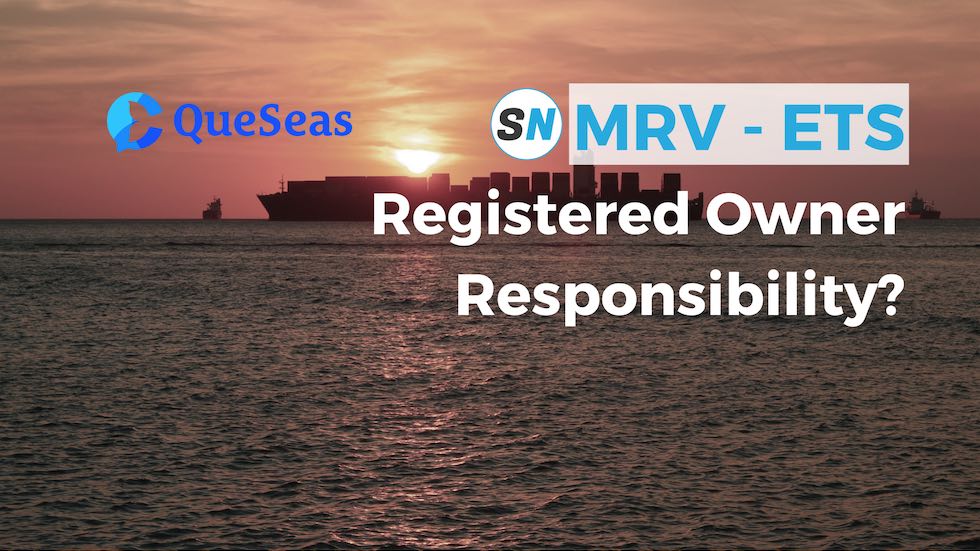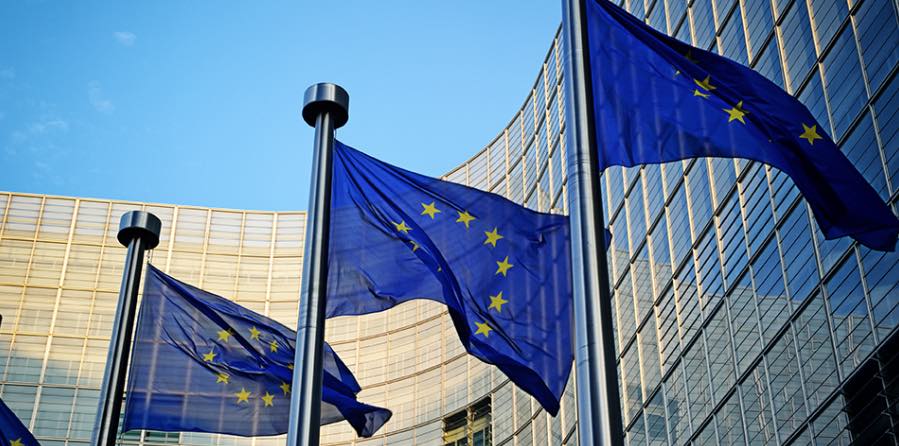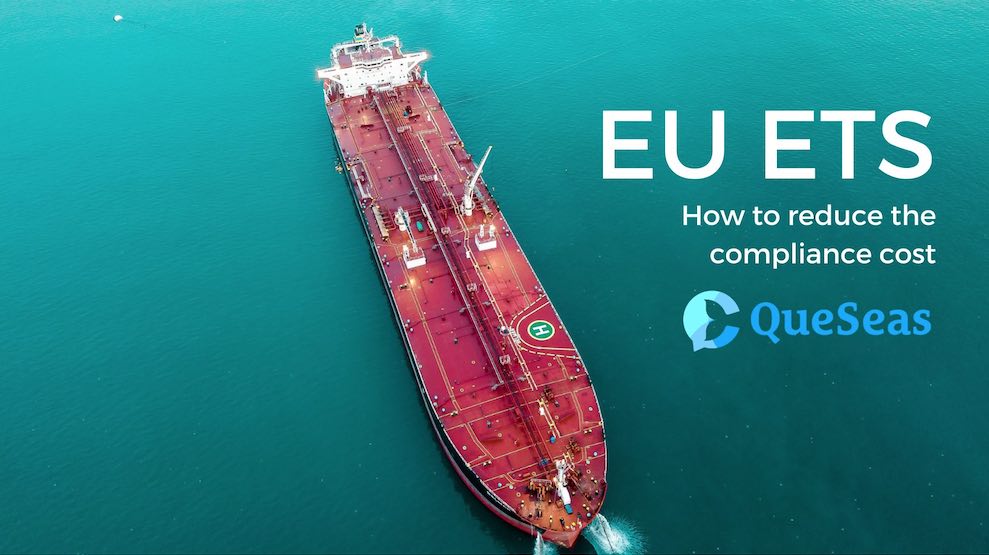28 November 2024
MRV & ETS – What if the Owner Assumes Responsibility?

Have you ever wondered what if the vessel’s registered Owner assumes responsibility for MRV & ETS? QueSeas got you covered with this on-point article.
Table of Contents
MRV / ETS Key Principle
Since the beginning of 2024, many shipping companies have been looking to comply with the EU ETS requirements. According to the key principle, the entity responsible for ETS compliance is necessarily responsible for MRV compliance. Hence, the entity responsible for compliance with ETS and MRV can be either the
- Registered Owner or
- ISM company
By default, the registered owner is the entity responsible for compliance with the EU ETS obligations and surrendering the allowances. However, the registered owner and the ISM company can agree, according to which the ISM company is the entity responsible for compliance with the EU ETS obligations. In this case, there is an obligation to have a document signed by the registered owner and the ISM company that clearly shows the existence of a mandate.

EU ETS & Ship Purchase – Beware before you buy in 2024
The EU ETS will include shipping from 1 January 2024. The NorthStandard has spoken to Verifavia to understand the implications on ship purchase.
Ship Nerd
Case Study Scenario
But, what if the registered owner wants to maintain the responsibility for ETS and consequently the MRV?
Let’s explore the actions that need to be followed in this scenario in which the registered shipowner wants to maintain the responsibility for ETS and consequently the MRV. Note that the owner listed on a ship’s certificate of registry is the registered owner.
Change of Company
If the registered owner assumes responsibility for MRV (and ETS) during a reporting period (e.g. 2024), the ISM company is required to provide a partial emissions report for each vessel within three months of the change.
As per the updated MRV Maritime Regulation, when a change of company occurs, the previous company must produce a verified report covering the same elements as the (annual) emissions report but limited to the period corresponding to the activities carried out under the company’s responsibility (referred to as the ‘partial emissions report’).
Please be aware that a partial emissions report cannot be submitted via THETIS-MRV for a ship once it has been released from the company’s fleet. Therefore, the release of the ship in THETIS-MRV should occur after the submission of the partial emissions report.
The number of allowances to be surrendered needs to correspond only to emissions that occurred during the time of responsibility of a particular company for the vessels.
This means that if there is a change of shipping company from Company A to Company B for example on 1 March 2024, then in 2025, Company A will need to surrender allowances corresponding to emissions from that ship from 1 January to 1 March 2024 [see Article 11(2) of the MRV Maritime Regulation for further details].
In compliance with Article 7 of the MRV Maritime Regulation, a company shall modify the monitoring plan when there is a change of company.
Should the registered owner assume responsibility for MRV (and ETS) duties from the former ISM company without further alterations to the ship’s monitoring plan, reassessment by verifiers is not required. The company needs to only submit the updated monitoring plan to the relevant administrative authority for approval.
Registered Owner & Verifier
The Registered Owner shall have an agreement with the Verifier, meaning a legal entity accredited by a national accreditation body under Regulation 765/2008, carrying out verification activities to assess the conformity of the documents transmitted by the Company.
Registered Owner & Administering Authority (AA)
Implementing Decision 2024/411 lists the attributed AA for shipping companies based on information available in THETIS-MRV and the European Union maritime information and SafeSeaNet as of 20 November 2023.
For companies that know which AA they are assigned to, it is recommended to apply for a Maritime Operator Holding Account (MOHA) as soon as possible.
In the case of a shipping company not on the list but covered by the EU ETS, this shipping company will be attributed to a Member State based on the rules under Article 3 gf of the ETS Directive. EMSA can help a shipping company to determine its MS (Dedicated Helpdesk: [email protected]).
a. For EU-registered shipping companies, that Member State will be the administering authority.
b. For any non-EU registered shipping companies, which are not listed in the list and own vessels that have undertaken a commercial voyage to an EU/EEA port since January 1, 2024, falling under the scope of the EU ETS, the AA shall be, according to EU Regulation 2023/2599:
i. The MS from which the vessel’s first voyage subject to the EU ETS started or finished; or
ii. In the instance where two or more Member States had the equal highest number of port calls by their ships in the scope of ETS, the AA will be the first port call to the Member State with the joint highest port calls in the scope of ETS.
As per Delegated Regulation (EU) 2023/2904 Article 15a, the shipping company with responsibility for EU ETS compliance must open a MOHA in the Union Registry:
a. Within 40 working days for shipping companies, which are included in the published list of assigned AA (Regulation 2024/411).
b. Within 65 working days of the first port of call falling within the scope of the ETS Directive for shipping companies not listed in Regulation 2024/411.
The registered owner should provide its Administering Authority (AA) with a list of ships for which it assumes responsibility with the MRV and ETS obligations. The registered owner must establish its monitoring system, develop a Monitoring Plan, have it assessed by a verifier (if necessary), and submit it to the AA by 1 April 2024.
Irrespective of the assigned AA, the submission of Monitoring Plans and emissions reports is carried out through Thetis MRV. A Thetis account can be created via the Thetis platform at any time for companies (shipowner or any other organization responsible for ship operations), verifiers, and MS. Upon creating an account, the user will receive an email detailing further steps to activate the account. It’s important to note that only one responsible person per Company / Verifier / Flag State is permitted, although this individual can create additional users under the same account. It is recommended to visit the EMSA website, paying special attention to the video tutorial C01, which covers the registration process.
Assistance from a Third Party
A third party can carry out operational tasks, such as monitoring and reporting, on behalf of the shipping company. If a third party provides services to a shipping company, they can be authorized to access Thetis MRV as a user. However, regardless of this arrangement between the third party and the shipping company, the shipping company retains responsibility for ensuring compliance with MRV and ETS obligations.
If the registered owner assumes responsibility for complying with the MRV and ETS but assigns operational monitoring tasks to the ISM company as a third party, the ISM company can proceed with the monitoring and reporting as usual. However, the Monitoring Plan must be revised to indicate the owner as the responsible entity. It has not yet been determined whether the ISM company will be permitted to submit plans and reports in Thetis MRV on behalf of the owner.

Shipping EU ETS new provisional agreement from 2024
The European Union Council and Parliament have reached a provisional deal to include shipping in the EU emissions trading system (EU-ETS).
Ship Nerd
Information for Registered Owners Maintaining Responsibility
List of Vessels
If the shipping company is the registered owner, it must provide its AA with a document containing the list of the ships under its responsibility for ETS and MRV compliance. The contents of this document for each ship with emissions falling within the ETS scope include the ship’s name and IMO ship identification number. The registered owner is obligated to promptly update the document in the following circumstances:
- The registered owner becomes responsible for an additional ship with emissions falling within the ETS scope, in which case the new ship’s name and IMO ship identification number must be provided.
- A ship ceases to be under the responsibility of the registered owner (e.g., the registered owner mandates the ISM Company to comply with ETS and MRV obligations; the registered owner sells the ship), in which case the ship’s name, IMO ship identification number, and the name and IMO unique company and registered owner identification number of the new shipping company must be provided.
MOHA Documentation
But, how can one open a Maritime Operator Holding Account (MOHA)? The request for opening a MOHA should be accompanied by a set of documents, including:
- IMO number
- Unique company and registered owner identification number
- Mandate (if any) by the registered owner to the ISM company (where the shipping company is the ISM company)
- List of ships under the responsibility of the registered owner (where the shipping company is the registered owner)
- Document identifying the structure of the group (if the shipping company is part of a group)
- National administrators may ask for additional documents depending on national rules e. g. bank account details, information on the beneficial owner of the legal entity)
When requesting the MOHA, the shipping company must nominate at least two authorized representatives with access to the MOHA. An authorized representative is a natural person over the age of 18, and their role involves acting on behalf of the shipping company (e.g., surrender of allowances). It’s important to note that a third party may serve as the authorized representative (AR) on a MOHA.
Union Registry
The Union Registry (UR) is an essential IT system designed to ensure the accurate and secure tracking of ETS allowances, functioning in a manner like online banking. It includes various types of accounts, such as operator holding accounts, such as the Maritime Operator Holding Account (MOHA) and Trading Accounts (TA).
Hence, the UR maintains records of annual verified greenhouse gas emissions and facilitates the annual reconciliation of allowances and verified emissions. Moreover, the UR facilitates the transfer of allowances between participants.
Source: QueSeas
See Also
QueSeas has published an article focusing on the side effects of the inclusion of shipping in the EU Emissions Trading System (EU ETS).
The enforcement of the EU ETS may give industry stakeholders financial incentives to avoid voyages in the European Economic Area (EEA) and utilize neighboring non-EU countries as intermediate calls. This study investigates the carbon leakage possibility in the crude oil trade of the EU. Exploring three scenarios based on three common crude oil trading routes. Our results show that alternative pathways could lead to revenue loss for the EU ETS and increase the risk of carbon leakage.

A potential loophole in the EU ETS
Queseas has published an article focusing on the side effects of the inclusion of shipping in the EU Emissions Trading System (EU ETS).



